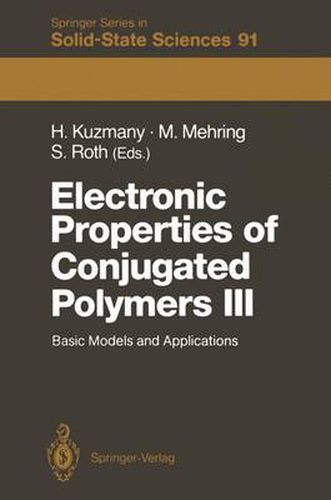Readings Newsletter
Become a Readings Member to make your shopping experience even easier.
Sign in or sign up for free!
You’re not far away from qualifying for FREE standard shipping within Australia
You’ve qualified for FREE standard shipping within Australia
The cart is loading…






This title is printed to order. This book may have been self-published. If so, we cannot guarantee the quality of the content. In the main most books will have gone through the editing process however some may not. We therefore suggest that you be aware of this before ordering this book. If in doubt check either the author or publisher’s details as we are unable to accept any returns unless they are faulty. Please contact us if you have any questions.
The International Winter School on Electronic Properties of Polymers and Re- lated Compounds, held March 11-18, 1989, in Kirchberg (Austria), was a sequel to two meetings on similar subjects held there two and four years be- fore. The 1989 winter school was again organized in cooperation with the Bundesministerium flir Wissenschaft und Forschung in Austria, and with the Bundesministerium fUr Forschung und Technologie in the Federal Republic of Germany. The basic idea of the meeting was to provide an opportunity for experienced scientists from universities and industry to discuss their most recent results and for students and young scientists to become familiar with the present status of research and applications in the field. Like the previous winter schools, this one concentrated on the electronic structure and application potentialities of polymers. A purely tutorial contribu- tion on high-temperature supercondutors was included. Special attention was paid this time to our present theoretical understanding of the electronic struc- ture of polymers in general, the role of disorder and the nature of the doping process in particular. Accordingly, two discussion meetings were held on the stability of quasiparticles in conjugated polymers and on the thermochromic phase transition in alkylated thiophenes. As a general result, disorder and con- jugation length were recognized as fundamental properties, not only for the stability of the quasiparticles but also for linear and nonlinear optics, transport, phototransport, magnetic properties, lattice dynamics, etc.
$9.00 standard shipping within Australia
FREE standard shipping within Australia for orders over $100.00
Express & International shipping calculated at checkout
This title is printed to order. This book may have been self-published. If so, we cannot guarantee the quality of the content. In the main most books will have gone through the editing process however some may not. We therefore suggest that you be aware of this before ordering this book. If in doubt check either the author or publisher’s details as we are unable to accept any returns unless they are faulty. Please contact us if you have any questions.
The International Winter School on Electronic Properties of Polymers and Re- lated Compounds, held March 11-18, 1989, in Kirchberg (Austria), was a sequel to two meetings on similar subjects held there two and four years be- fore. The 1989 winter school was again organized in cooperation with the Bundesministerium flir Wissenschaft und Forschung in Austria, and with the Bundesministerium fUr Forschung und Technologie in the Federal Republic of Germany. The basic idea of the meeting was to provide an opportunity for experienced scientists from universities and industry to discuss their most recent results and for students and young scientists to become familiar with the present status of research and applications in the field. Like the previous winter schools, this one concentrated on the electronic structure and application potentialities of polymers. A purely tutorial contribu- tion on high-temperature supercondutors was included. Special attention was paid this time to our present theoretical understanding of the electronic struc- ture of polymers in general, the role of disorder and the nature of the doping process in particular. Accordingly, two discussion meetings were held on the stability of quasiparticles in conjugated polymers and on the thermochromic phase transition in alkylated thiophenes. As a general result, disorder and con- jugation length were recognized as fundamental properties, not only for the stability of the quasiparticles but also for linear and nonlinear optics, transport, phototransport, magnetic properties, lattice dynamics, etc.